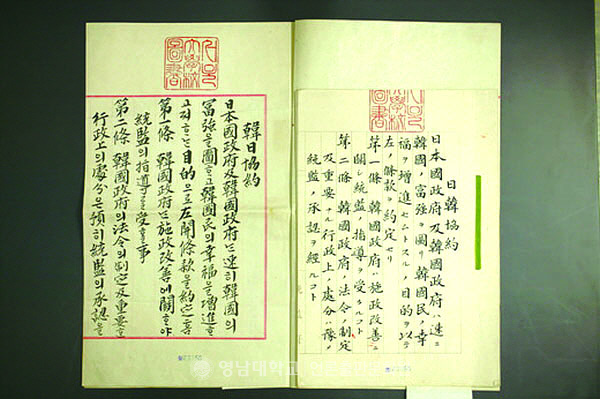
Conclusion of the Eulsa Treaty
The Japanese empire entered into the Eulsa Treaty forcibly with the Korean empire in order to disqualify the Korean empire’s diplomatic rights on 17 November, 1905. The official name is the Korea-Japan Negotiation Treaty, and it is also called the Second Korea-Japan Convention, the Eulsa 5 Treaty, and the Eulsa Treaty. When the Russia-Japanese War broke out, the Japanese empire forced the Korea-Japan Protocol on 23 February, 1904, and then signed the First Korea-Japan Convention (the agreement on the use for the Korean-Japanese foreign advisors) on August 22, depriving the real power of finance and diplomacy, and controlling the whole state of the Korean empire. The Japanese empire, which won the Russo-Japanese War, was guaranteed that if the Korean empire’s consent was obtained by any means in the strengthening treaty with Russia in Portsmouth, USA, on September 5, it could infringe on the sovereignty of the Korean empire. To colonialize the Korean empire, the consent of the Korean empire was absolutely necessary. However, Gojong, who was the emperor of the Korean empire, disagreed.
In the end, the Japanese empire tried to enact a treaty with Han Kyu-seol, Min Young-ki, Lee Ha-yeong, Lee Wan-yong, Lee Geun-taek, Lee Ji-yong, Park Je-soon and Kwon Jung-hyun, everyone except for the emperor. Among them, Han Gyu-seol and Min Young-ki actively opposed the treaty, Lee Ha-yeong and Kwon Jung-hyun expressed inactive opposition, and Kwon Jung-hyun later agreed this treaty. The other deputies were unable to overcome Ito the governor of Korea’s coercion and expressed their intention to approve on condition of some amendments. On that night, Ito held a meeting with the deputies in favor of the treaty, made some amendments in his own handwriting, and was approved for the treaty in a threatening atmosphere. Five people – Park Je-soon, Lee Ji-yong, Lee Geun-taek, Lee Wan-yong, and Kwon Jung-hyun, who are called the ‘Eulsa 5 traitors’ – were in favor of signing the treaty.
The Treaty of Eulsa was an invalid treaty in many ways. First, in order for the treaty to take effect, it needed Emperor Gojong’s seal, but due to the opposition of Gojong, Park Je-soon signed the treaty with his seal. In addition, when they signed, the atmosphere between the two empires was nothing but coercive.
After the signing of the Eulsa Treaty, there was a lot of opposition from home and abroad. First, Gojong sent Lee Jun, Lee Sang-seol, and Lee Yi-jong to The Hague in the Netherlands where the Hague Peace Conference was held. However, this movement was discovered by the Japanese empire and in the aftermath, Gojong was forced to abdicate. Lee Jae-myeong tried to assassinate Lee Wan-yong but failed. Jang Ji-yeon wrote an essay in the Hwangseong Newspaper, “Siilyabangsungdaegok,” criticizing the unfairness of that treaty, and many people also resisted the Japanese empire by raising armies in the name of justice.
Gwangju Student Independence Movement
The Gwangju Student In dependence Movement triggered a collision between Korean and Japanese students on a commuter train from Gwangju to Naju on 30 October, 1929. On the school train, Japanese students sexually harassed a Korean girl, and the Korean boys who witnessed the scene fought the Japanese students. In this incident, the Japanese police sided with the Japanese students. On the other side, the Korean students were struck unilaterally by the Japanese police. Outraged at the incident, students at Gwangju High School held a street demonstration in Gwangju on November 3. Upon hearing the news of the students’ protest, Singanhoe, the Youth Alliance of Joseon, and the Student Advance Guard Alliance dispatched investigation teams. As the news from Gwangju spread nationwide, student protests spread into neighboring areas such as Mokpo and Naju. Also, demonstrations took place in Seoul and other cities in December of that year and into January of the next.
According to Japan’s record, 194 schools and 54,000 students participated in this movement. As there were 89,000 students attending secondary or higher schools at the time, about 60 percent of Gwangju’s students participated in the protest movement. 1,600 of them were arrested in the process, 580 of them were expelled from school, and 2,330 were suspended indefinitely. The Gwangju Student Independence Movement is the largest anti-Japanese movement after the March 1st Independence Movement. During this movement, the students demonstrated the power of a mass movement organized by schools. The movement also had a great influence on the development of mass movements at all levels of society.
After liberation, the Korean government celebrated 3 November, 1953, as ‘Student’s Day’ on 20 October, 1953. Student’s Day was abolished on 30 March, 1973 to simplify the anniversary but was revived on 19 September, 1984. Furthermore, the date was changed to 9 February, 2006 as the Student Independence Movement Day.


